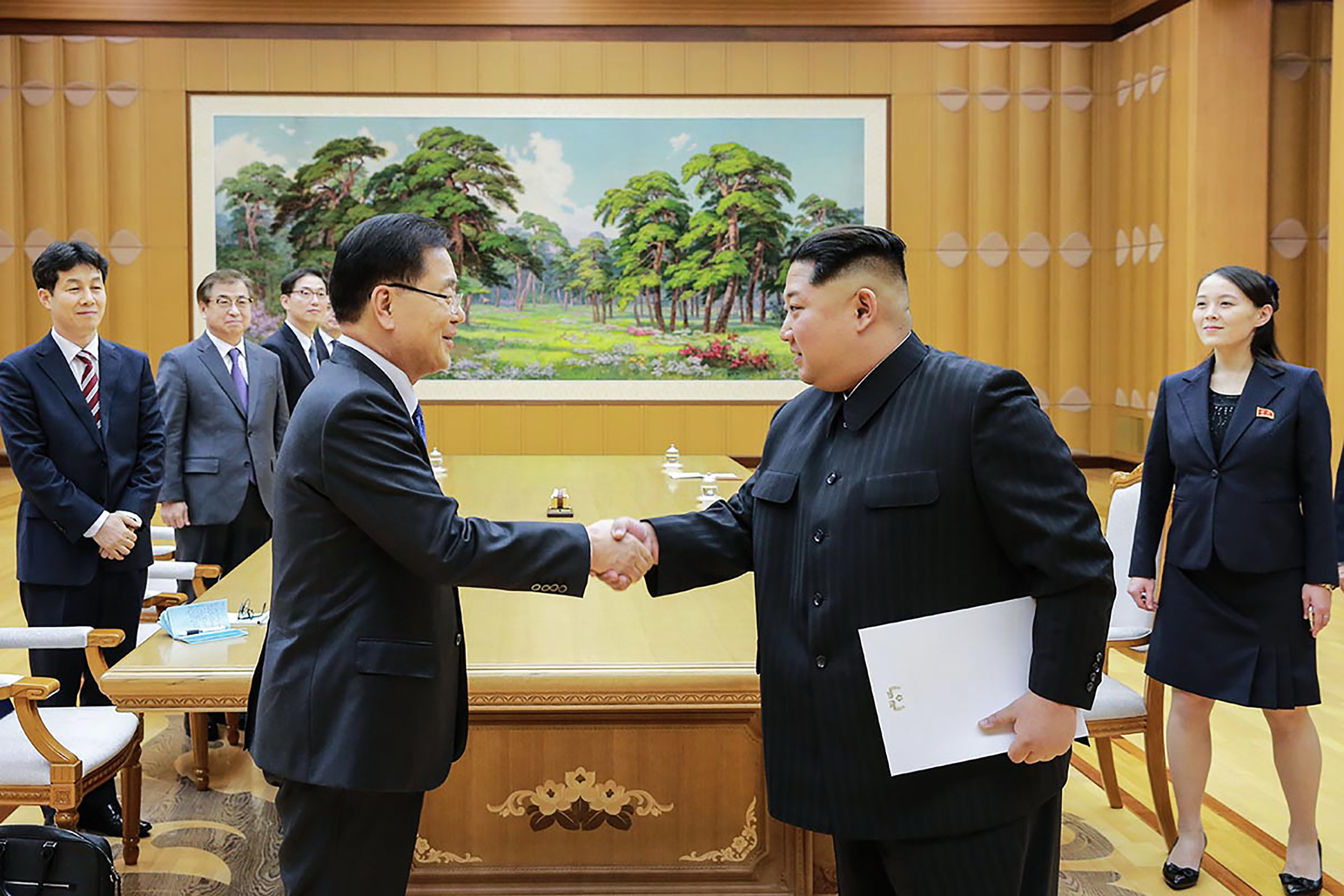Korea, South, is one of two countries on the Korean Peninsula, which extends south from northeastern China in Asia. South Korea covers the southern half of the peninsula, and North Korea occupies the northern half.
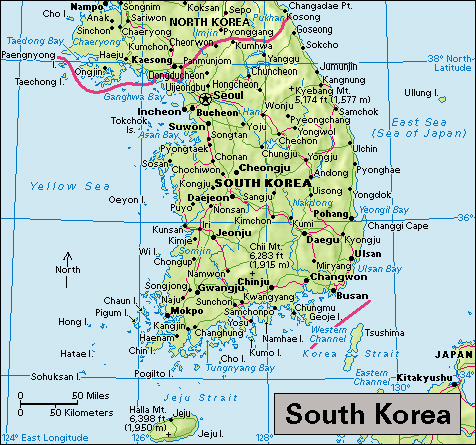
South Korea’s official name is the Republic of Korea. The country has a democratically elected government. Seoul is South Korea’s capital and largest city.
People probably have lived on the Korean Peninsula for at least 30,000 years. Various Korean and foreign governments ruled the peninsula from ancient times to the 1900’s. Korea was a colony of Japan from 1910 until World War II ended in 1945. After Japan’s defeat in the war, the United States occupied the South, and the Soviet Union occupied the North. In 1948, a pro-United States government was established in South Korea, and a Communist-led, pro-Soviet government was formed in North Korea.
From 1950 to 1953, North Korea and South Korea fought each other in the Korean War. The governments of China and the Soviet Union supported the North, and a U.S.-led United Nations coalition supported the South. The fighting ended with a cease-fire, but a permanent peace treaty was never signed. Since the war, small-scale clashes between South and North Korea have occasionally taken place.
Plains stretch along the western and southern coasts of South Korea. Hills and low-lying mountains cover most of the rest of the country. Most of the South Korean people live on the coastal plains or in river valleys.
Until the early 1900’s, the economy of what is now South Korea was based almost entirely on agriculture, and nearly all Koreans were farmers. Today, industry is far more important than agriculture. Before the 1960’s, South Korea was one of the world’s poorest countries. Since then, the country has experienced huge economic growth. Today, South Korea has one of the world’s largest and wealthiest economies.
Government
According to its Constitution, South Korea is a republic. National government leaders are elected by the people. The Constitution guarantees such rights as freedom of the press and freedom of religion. But the government can limit freedom in the name of national security.

National government.
The president of South Korea is the head of state and the country’s most powerful official. The people elect the president to a single five-year term. The president appoints a prime minister, who serves as the president’s chief executive. The president also appoints the members of the State Council, who head government ministries.
South Korea’s legislature, called the National Assembly, has 300 members. Voters elect the members of the National Assembly to four-year terms. South Koreans 18 years old or older may vote.
Loading the player...South Korea's national anthem
Local government.
South Korea has nine provinces. It also has cities that have the same status as provinces. These cities include Busan (also spelled Pusan), Daegu (also spelled Taegu), Daejeon (also spelled Taejon), Gwangju (also spelled Kwangju), Incheon (also spelled Inchon), Sejong, Seoul, and Ulsan. Each province is divided into two kinds of government units—cities and counties. Provincial governors, city mayors, and other city and county officials are elected by the people.
Politics.
Political parties in South Korea have frequently changed and reorganized. Today, parties include the Democratic Party of Korea, the Justice Party, the Open Democratic Party, the People’s Party, and the People Power Party.
Courts.
The Supreme Court, which is South Korea’s highest court, consists of a chief justice and up to 13 other justices. The president appoints the chief justice—and the other justices, who are recommended by the chief justice—with the approval of the National Assembly. Justices serve six-year terms. South Korea has a Constitutional Court that rules on such questions as the constitutionality of laws. Other courts include appeals courts, district courts, and a family court.
Armed forces.
South Korea has an army, a navy, and an air force. The government requires men to complete at least 21 months of military service. Women join the armed forces on a volunteer basis. About 3 million people are members of a civilian defense corps.
People
Ancestry.
Ethnic Koreans make up almost the entire population of South Korea. The country has a small minority of people of Chinese descent. In the first decades of the 2000’s, South Korea experienced increased immigration from other countries as well.
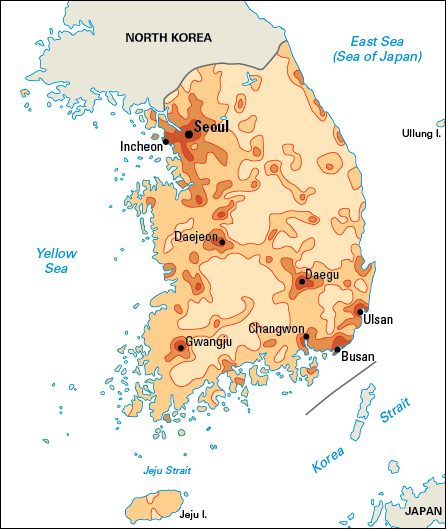
Language.
Korean is the official language of South Korea. About half of all Korean words come from Chinese. Korean has about seven major dialects (local forms). Most South Koreans understand all the dialects.
The Korean alphabet, called Hangeul (also spelled Han’gul), has 24 basic letters. It was developed by King Sejong and scholars at his court in the 1440’s. South Koreans also use some Chinese characters, called Hanja, in their writing.
Way of life
Before the 1900’s, the people of what is now South Korea lived in an agricultural society built on strong family ties. Most Koreans lived in small villages and worked on farms. In many families, several generations lived together. Typically, the oldest male served as head of the family.
Koreans’ way of life changed quickly after Japan seized control of the Korean Peninsula in 1910. The Japanese brought industry to Korean cities and took much farmland away from the farmers. They forcibly moved many young Koreans to the cities to work. The old way of life changed even more after Korea’s division into two countries in the 1940’s. In South Korea, economic and political ties with Western nations brought South Koreans under the influence of Western culture.
City life.
Changes in South Korea since the 1950’s have led to a rapid increase in the proportion of city dwellers. South Koreans are attracted to cities because of the opportunities there. Factories and businesses provide jobs. The cities have universities, better health-care facilities, and a variety of forms of entertainment.
Many high-rise apartment buildings and modern houses have been built in Seoul and other large South Korean cities. But it has been difficult to meet the rapidly rising need for housing, and many people must live in distant suburbs. The rise in population has also strained such public services as water, sewerage, and transportation. In addition, as South Koreans have become more prosperous, the number of automobiles has increased. Traffic jams are frequent.
Rural life.
Many people in rural areas live in single-family houses made of bricks or concrete blocks, with roofs of cement tiles and slate. In such homes, pipes carry heated water under the floors to provide heat. Other homes are heated using electric coils. Almost all rural homes have electric power. Most farmers have modern farm machinery.
Loading the player...Korean farmer's dance
Clothing.
Most people in South Korea wear clothing like that worn in other developed Asian countries, Europe, and the Americas. However, many people wear traditional clothing, known as hanbok, for holidays and special occasions. For women, this consists of a long, full skirt and a tight-fitting jacket. For men, hanbok includes loose-fitting trousers, shirts, and jackets.
Food and drink.
Rice is the staple food of most South Korean diets. Other common foods include barley; fish; such fruits as apples, grapes, melons, peaches, and pears; and such vegetables as beans, potatoes, and sweet potatoes. Rice is served with most meals. A popular side dish called kimchi consists of a highly spiced mixture of pickled cabbage and radish.
Tea is South Korea’s traditional beverage, but many people also drink coffee. Adults drink soju, a distilled alcoholic drink usually made from grain, as well as che’ong-ju, known in the West as sake or rice wine. Other popular alcoholic beverages in South Korea include beer, Western wine, and an unfiltered rice wine known as makgeolli (also spelled makkolli).
Recreation.
South Koreans enjoy most of the sports common in the West, including baseball, boxing, golf, soccer, table tennis, tennis, volleyball, and wrestling. They also enjoy such martial arts as judo, kendo, and taekwondo. Television and radio broadcasts of local and national athletic meets attract a wide audience. South Korea hosted the 1988 Summer Olympics and co-hosted the 2002 FIFA World Cup soccer tournament with Japan. The resort city of Pyeongchang hosted the 2018 Winter Olympics.

South Korean cities and towns have many theaters for motion pictures, plays, operas, and concerts. Orchestras perform classical and contemporary Western music. Television networks show dramas and comedies. South Koreans enjoy reading novels, short stories, and poems. 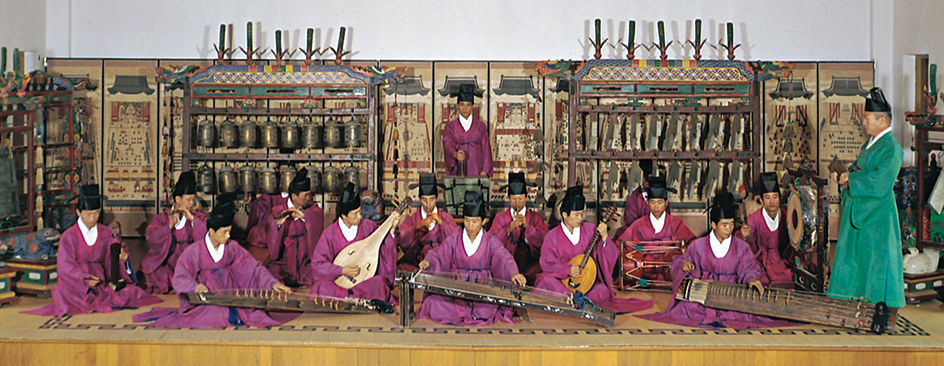
Religion.
South Koreans have complete freedom of religion. Traditionally, many Koreans have been followers of Confucianism, which is more a moral philosophy than a religion. It stresses the duties that people have toward one another. Today, most South Koreans participate in at least some Confucian practices. For example, many families follow the Confucian practice of honoring their ancestors in special traditional ceremonies. About 16 percent of South Koreans are Buddhists, about 20 percent are Protestants, and about 8 percent are Roman Catholics. Some 57 percent of South Korea’s people are not religiously active. 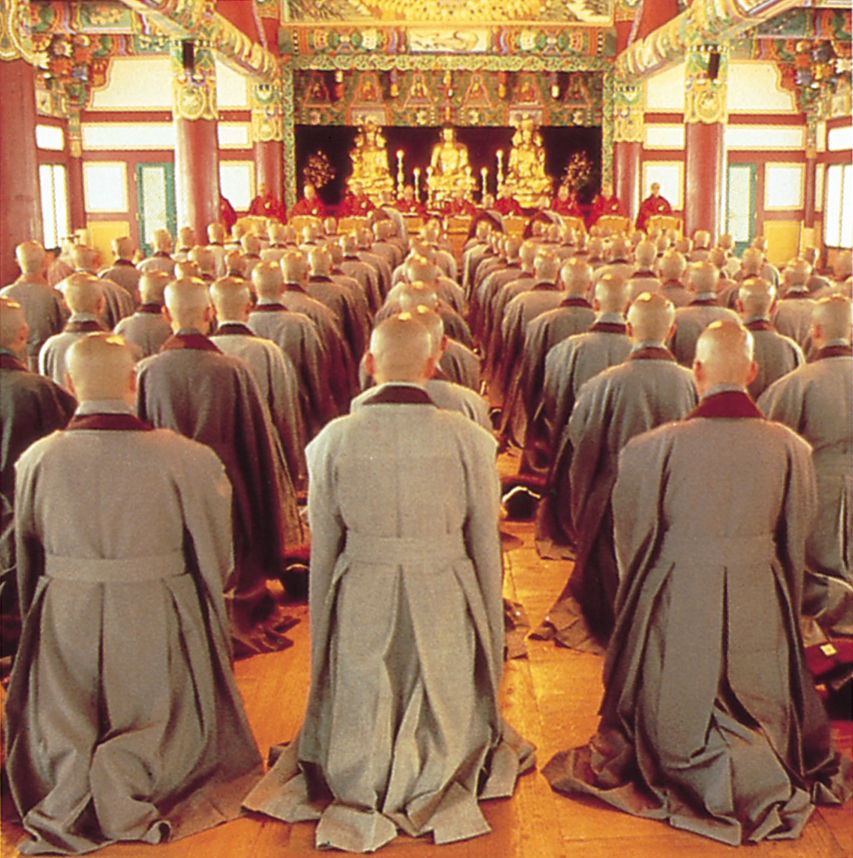
Education.
Since the late 1940’s, South Korea has made special efforts to improve and expand its educational system. As a result, the number of South Koreans who can read and write has increased from less than half of the adult population in the mid-1940’s to almost all of the adults today.
Loading the player...Korean folk music
South Korean law requires nine years of schooling. Children attend elementary school (up to grade 6) and middle school (grades 7 through 9). Public elementary and middle schools in South Korea are free. Students may then attend high school (grades 10 through 12). Parents must pay tuition for public as well as private high schools. Nevertheless, the vast majority of children go on to attend high school. Technical training, which prepares students for industrial jobs, begins in the middle schools and continues through all higher levels of education.
Most South Korean students graduate from high school, and the majority of them pursue higher education. Qualified high school graduates may enter one of South Korea’s more than 300 universities, colleges, and junior colleges. These schools provide training in a wide variety of subjects for some 3 million students.
The arts.
Early Korean art developed under the influence of both Chinese art and the teachings of Buddhism and Confucianism. Popular themes included love of nature, respect for learning, respect for elders, and loyalty to the king. The most widely practiced art forms included music, poetry, pottery, sculpture, and painting.
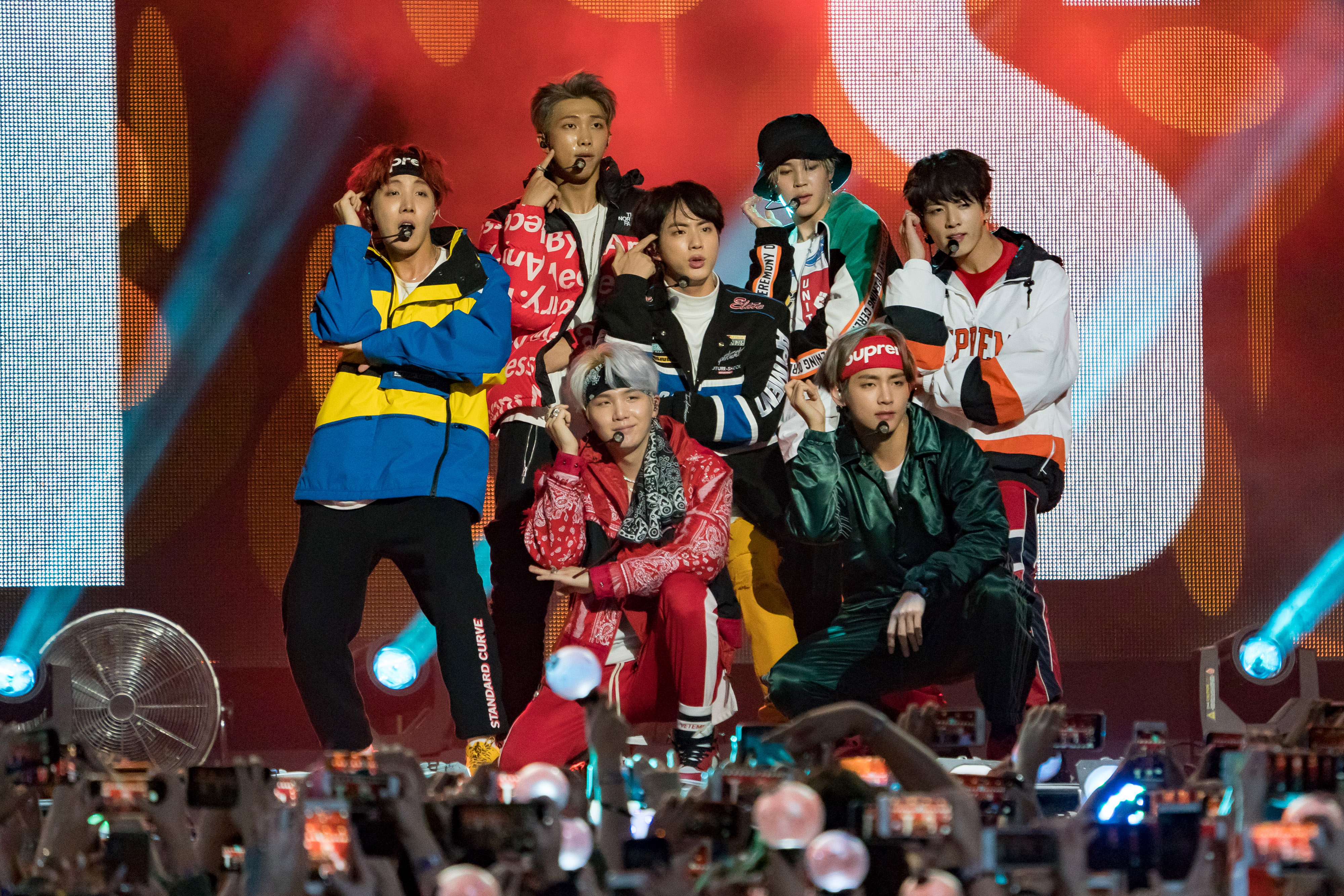
Today, South Korean artists work with traditional themes and with Western art forms. Western art has influenced many kinds of South Korean art. This influence appears especially in the rapid development of Western forms of drama and motion pictures since 1945.
The land
South Korea covers the southern part of the Korean Peninsula. A 487-square-mile (1,262-square-kilometer) demilitarized (neutral) zone separates South Korea from North Korea. The East Sea, also called the Sea of Japan, lies east of South Korea and separates the country from Japan. The Yellow Sea lies west of South Korea.
Forested hills and low-lying mountains cover most of central and eastern South Korea, including much of the seacoast. River valleys, hillsides, and some land along the coast are used for farming. The coastal waters yield large amounts of fish.
Plains separated by low hills cover the entire southern coast and almost the entire western coast. These regions are important centers for agriculture. Most of South Korea’s important industrial centers, such as Busan and Seoul, are also in the southern and western plains regions. About three-quarters of South Korea’s people live in these plains regions.
The Nakdong (also spelled Naktong) River, which is 325 miles (523 kilometers) long, is South Korea’s longest river. It flows from the central mountains south to the Korea Strait. The Han River flows from the central mountains west to the Yellow Sea.
Most of South Korea’s small islands are unpopulated. People live on the larger ones. Jeju (also spelled Cheju) Island, approximately 50 miles (80 kilometers) south of the peninsula, is the largest island. It covers about 700 square miles (1,800 square kilometers). Jeju has its own provincial government. Mainland provinces govern the other islands. South Korea’s highest mountain, Hallasan (Halla Mountain), rises 6,398 feet (1,950 meters) on Jeju Island.
Climate
Seasonal winds called monsoons affect South Korea’s weather throughout the year. A monsoon blows in from the south and southeast during the summer, bringing hot, humid weather. A cold, dry monsoon blows in from the north and northwest during the winter, bringing cold weather.
July temperatures in South Korea range between 72 and 77 °F (22 and 25 °C). South Korea’s hills shield the east coast from the winter monsoon. As a result, the east coast generally has warmer winters than does the rest of the country. January temperatures range between 23 and 37 °F (–5 and 3 °C).
Most of South Korea receives from 30 to 50 inches (76 to 130 centimeters) of precipitation (rain, melted snow, and other forms of moisture) yearly. Heavy rainfall from June through August accounts for about half of the yearly precipitation. In most years, one or two typhoons hit the Korean Peninsula during July and August.
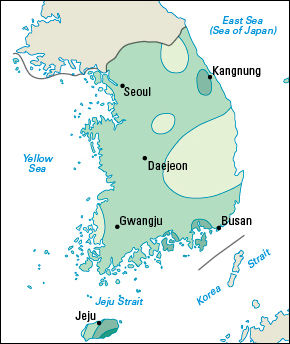
Economy
Before the Korean War (1950-1953), South Korea’s economy depended chiefly on agriculture, though there was some light industry. After the war, industrial production, especially manufacturing, grew rapidly. In addition, such service activities as communication, government, trade, and transportation grew in importance. Today, South Korea’s economy is one of the largest in the world.
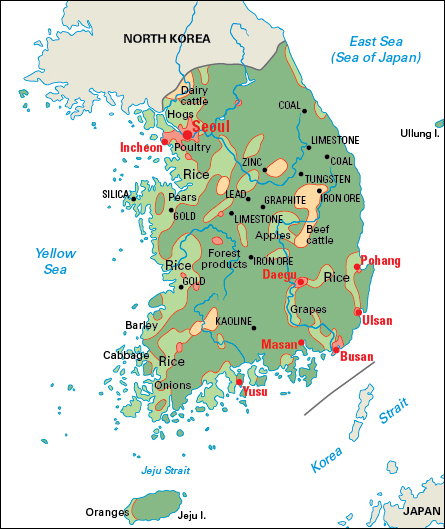
Service industries
are economic activities that provide services rather than produce goods. Service industries, as a group, account for over two-thirds of South Korea’s employment and over three-fifths of the country’s gross domestic product (GDP)—the total value of all goods and services produced within the country in a year. Such industries are especially important to the Seoul area.
Finance, insurance, real estate, and business services form South Korea’s leading service industry group, in terms of the country’s GDP. Wholesale and retail trade, hotels, and restaurants form the leading service industry employer. This group benefits from the millions of tourists who visit South Korea each year. Many tourists come from China, Japan, Taiwan, and the United States. Education, government services, and transportation and communication also contribute much to South Korea’s economy.
Industrial activities
account for about one-fourth of South Korea’s employment and about one-third of its GDP. Most of South Korea’s industry is privately owned.
Manufacturing employs more people and contributes more to South Korea’s GDP than any other single economic activity. After the Korean War, South Korea developed heavy industry, and the country now ranks as a major producer of automobiles, chemicals, computer equipment and parts, electric appliances, fertilizers, iron and steel, machinery, ships, telecommunications equipment, and television sets. Other manufactured products include cement, clothing, processed foods, rubber tires, and textiles.
Construction is also an important industrial activity. South Korea’s change from an agricultural economy to a modern industrial economy spurred a boom in construction. Factories, office and apartment buildings, highways, and water and sewerage systems have been built throughout the nation.
South Korea has few mineral reserves and relies on imports to meet its needs. The country’s leading mined products include anthracite (hard coal), cadmium, gold, iron ore, lead, limestone, silver, and zinc.
Agriculture and fishing
account for a small portion of South Korea’s GDP. South Korea’s agricultural production has been steadily decreasing. As a result, the country has become more reliant on imports to meet its food needs.
Rice is by far the country’s chief crop. South Korean farms also produce apples, barley, cabbage, grapes, onions, pears, potatoes, strawberries, sweet potatoes, and tomatoes. Farmers raise cattle, chickens, and hogs. The country’s major agricultural areas lie along the western and southern coasts and in the river basin areas. Oranges and tangerines are harvested in southern regions. 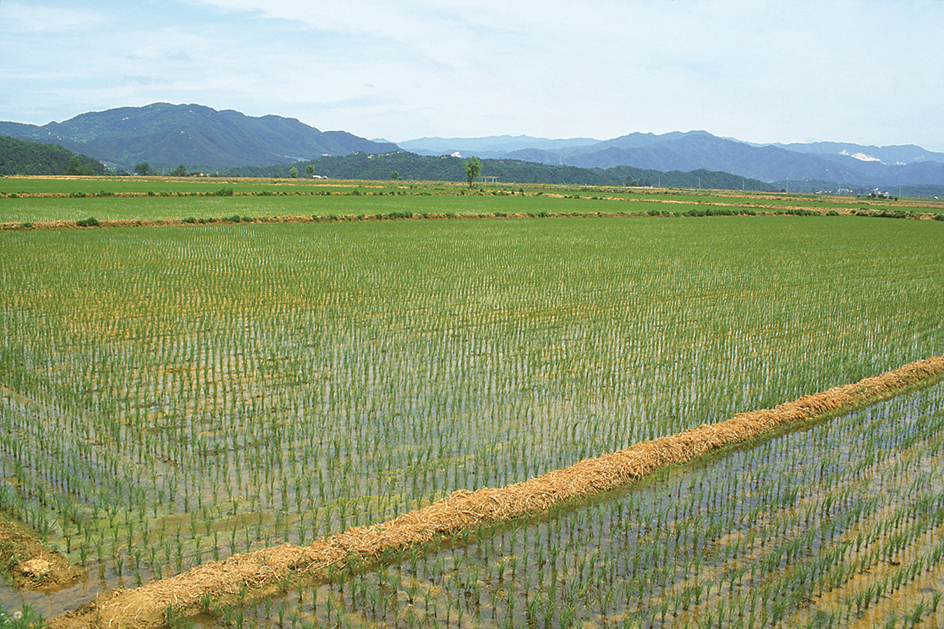
South Korea is one of the world’s leaders in the fishing industry. The catch includes anchovies, mackerel, squid, and tuna. Many farmers add to their income by fishing.
International trade.
South Korea’s chief trading partners include Australia, China, Japan, Saudi Arabia, the United States, and Vietnam. South Korea’s main exports include automobiles, chemicals, electronics, plastics, refined petroleum products, and ships. Chemicals, crude oil, electrical and electronic equipment, food products, iron and steel, machinery, and transportation equipment are among its main imports.
Energy sources.
Petroleum-burning plants provide much of South Korea’s energy consumption. Coal, natural gas, and nuclear power provide most of the rest. South Korea imports all of its petroleum and most of its coal and natural gas. Nuclear power is increasing in importance. A small percentage of South Korea’s electric power comes from solar power and water power.
Transportation.
South Korea has an excellent government-owned railroad system and a highway network that includes expressways between the principal cities. However, traffic jams occur frequently. Most urban households own at least one car. Buses and trains provide fast and frequent service. A high-speed railroad links Seoul with Busan and other cities. Seoul and other major cities have subway systems. 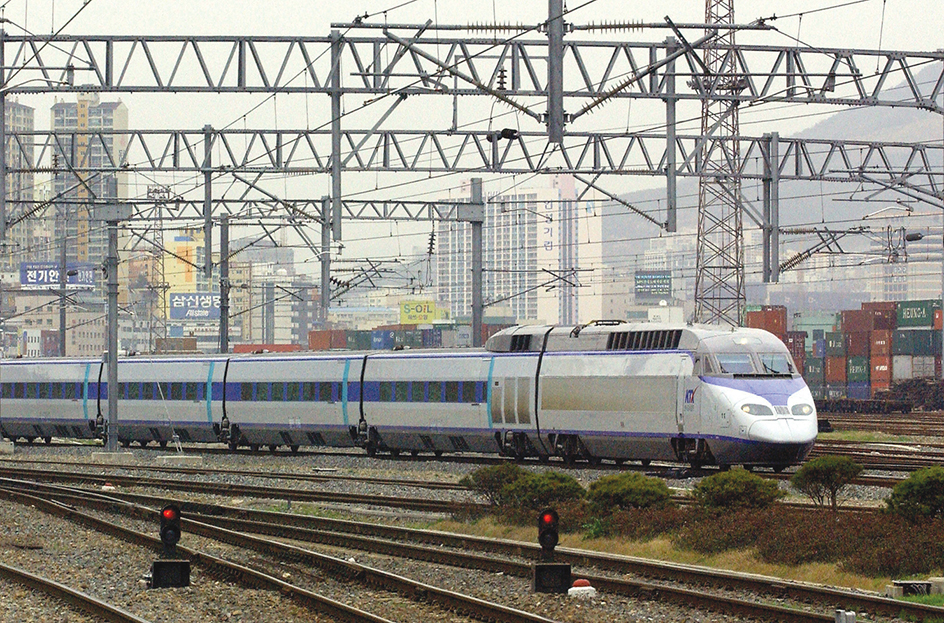
Korean Air, a privately owned airline, provides international flights and service between major South Korean cities. Several smaller airlines provide shorter-distance services in and around the country. Incheon has the largest international airport. Busan has a large seaport that handles most of the country’s international trade.
Communication.
Private and government-owned radio and television networks broadcast throughout South Korea. More than 100 daily newspapers are published in South Korea. The largest ones are privately owned, published in Seoul, and sold throughout the country. Internet use is widespread in South Korea.
History
Early years.
Scientists have evidence that people lived in the southwestern part of the Korean Peninsula about 30,000 years ago. Much later, the ancestors of today’s Koreans arrived in the peninsula from the north. Scholars do not know for sure when this migration occurred, but it may have been about 5,000 years ago.
In 2333 B.C., according to tradition, the first Korean state developed along the Daedong River (also called Taedong River), near present-day Pyongyang in North Korea. It was called Joseon (also spelled Choson). In 108 B.C., China conquered the northern half of the peninsula and established four territories there. Korean tribes won back three of the territories by 75 B.C. The other territory, called Lelang, remained under Chinese control.
During the last century B.C., several Korean tribes united and formed the state of Goguryeo (also spelled Koguryo) in the northeastern part of the peninsula. Two other Korean states—Baekje (also spelled Paekche) in the southwest and Silla in the southeast—were formed at about the same time. Historians call Goguryeo, Paekche, and Silla the Three Kingdoms. 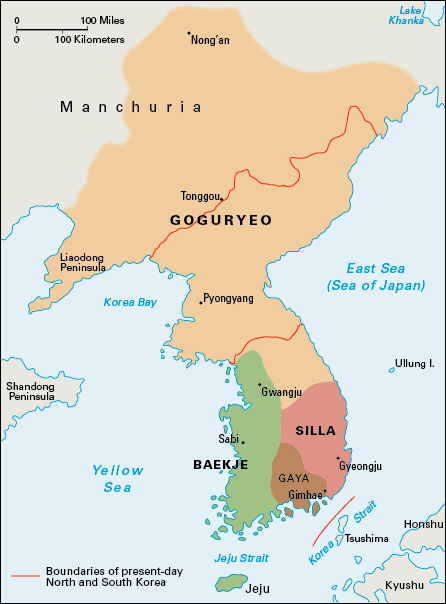
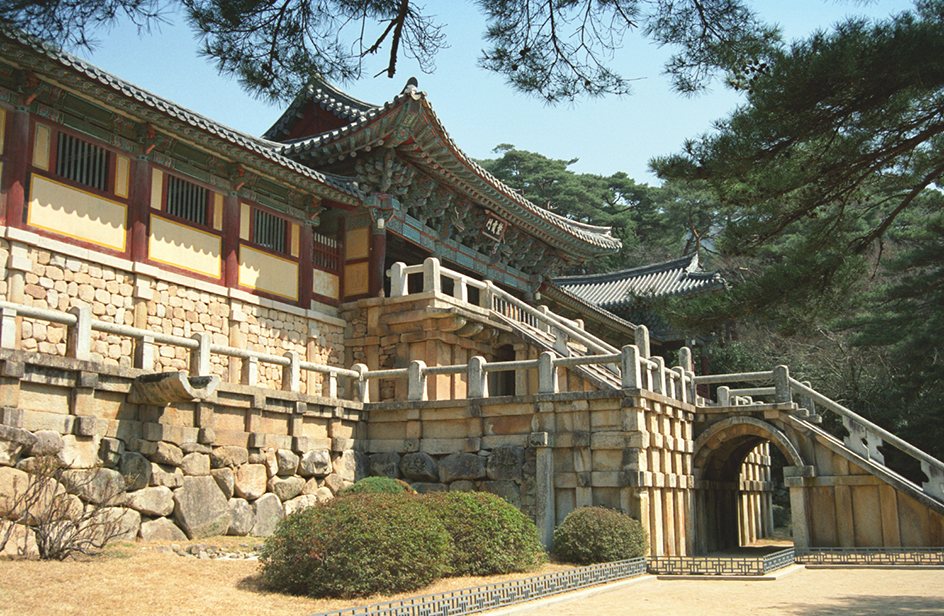
In 313, Goguryeo conquered Lelang and took control of the northern half of Korea. Buddhism, which the Koreans had learned about from the Chinese, became the chief religion of the Three Kingdoms in the 300’s and 400’s. In the 500’s and 600’s, wars raged among the Three Kingdoms for control of Korea. With the help of the Chinese Tang dynasty, Silla conquered Baekje and Goguryeo in the 660’s and took control of most of the peninsula. A dynasty is a line of rulers belonging to the same family. Korean art and learning flourished during the next 200 years. Confucianism, introduced into the peninsula from China, became a strong influence on Korean thought and behavior.
In the late 800’s, Silla broke apart as the kingdom lost control over former Goguryeo and Baekje territories to rebel leaders. But by 935, a general named Wang Geon (also spelled Wang Kon) had conquered Silla and the surrounding states and renamed the area Goryeo (also spelled Koryo). The name Korea comes from Goryeo. The government of Goryeo built schools and encouraged the development of printing to make more books available. The Koreans invented the first movable metal printing type in 1234.
Mongol tribes from the north repeatedly attacked Goryeo from the early 1230’s until they conquered it in 1259. Goryeo regained its freedom in 1368 when the Ming dynasty rose to power in China. Two groups, one allied with the Mongols, the other with the Ming dynasty, fought for control of Goryeo. In 1388, a general named Yi Songgye led the Ming-allied group to victory.
The Joseon dynasty.
General Yi became king of Goryeo in 1392 and renamed the country Joseon (also spelled Choson). Today, Choson (or Joseon) is one of the names North Koreans use for their country. South Koreans call their country Daehanminguk, often shortened to Hanguk.
Yi founded a dynasty called the Joseon dynasty (also known as the Yi dynasty). The dynasty lasted until 1910. Yi made Confucianism the national philosophy and ended the government’s official support of Buddhism that had existed since the 700’s. Buddhism declined in importance and did not become popular in Korea again until the 1900’s.
Yi and the rulers who followed him reunited Korea, reorganized the government, and promoted the arts. In the 1400’s, they regained lost territory and established the northern boundaries of what is now North Korea. But during the 1500’s, government officials and wealthy landowners began to struggle for political power. This struggle weakened Korea’s government.
Japanese forces invaded Korea in the 1590’s but were driven out with the assistance of Chinese forces. Manchu armies from the north invaded in the 1630’s. The Manchus forced Koreans to submit tributes (payments), but members of the Yi family continued as kings.
In the 1600’s, Korea’s rulers closed the country to all foreigners except Chinese and Japanese. The closure continued for almost 200 years. Korea was called the Hermit Kingdom during this period. Roman Catholicism came to Korea from China in the 1780’s. Catholic missionaries from Europe first arrived during the 1830’s. But Korean authorities persecuted the missionaries and killed thousands of Koreans who had become Catholics.
Korea under Japan.
In 1876, Japan forced Korea to open some ports to trade. Soon thereafter, the United States, Russia, and several European nations signed commercial treaties with Korea. An intense rivalry over control of Korea began. Japan defeated China in the Sino-Japanese War of 1894-1895, and Japan’s influence in Korea became stronger than China’s. Japan’s victory over Russia in the Russo-Japanese War (1904-1905) forced Russia to recognize Japan’s superior influence in Korea. Japan took complete control of Korea in 1910.
The Japanese governed Korea as a colony to benefit their own interests. During the 1930’s, the Japanese built many heavy industries in Korea to supply Japan with chemicals, iron and steel, machinery, and other goods. In the 1940’s, the Japanese forced the Koreans to take Japanese-style names, and they banned the use of the Korean language in public. Many Koreans were forced to aid the Japanese war effort during World War II (1939-1945). Some were sent to work in mines and factories inside and outside Korea. Others were drafted into the Japanese military. Some Korean women were forced to work as prostitutes for the Japanese armed forces.
A divided peninsula.
Korea remained under Japanese control until 1945, when Japan was defeated in World War II. After Japan’s defeat, United States troops occupied the southern half of Korea, and forces of the Soviet Union occupied the northern half. The United States and the Soviet Union tried to develop a plan for reuniting Korea. They failed, and the United States submitted the problem to the United Nations (UN) in 1947.
The UN wanted to supervise elections to choose one government for Korea. But the Soviet Union refused to allow UN representatives into the North. In the South, in 1948, UN representatives supervised an election of representatives to a National Assembly. The Assembly drew up a constitution. In July 1948, the Assembly elected Syngman Rhee president of the Republic of Korea, which was formed on August 15. In northern Korea, the Communists formed the Democratic People’s Republic of Korea on September 9, with Kim Il-sung as premier. Both governments claimed to represent all of Korea.
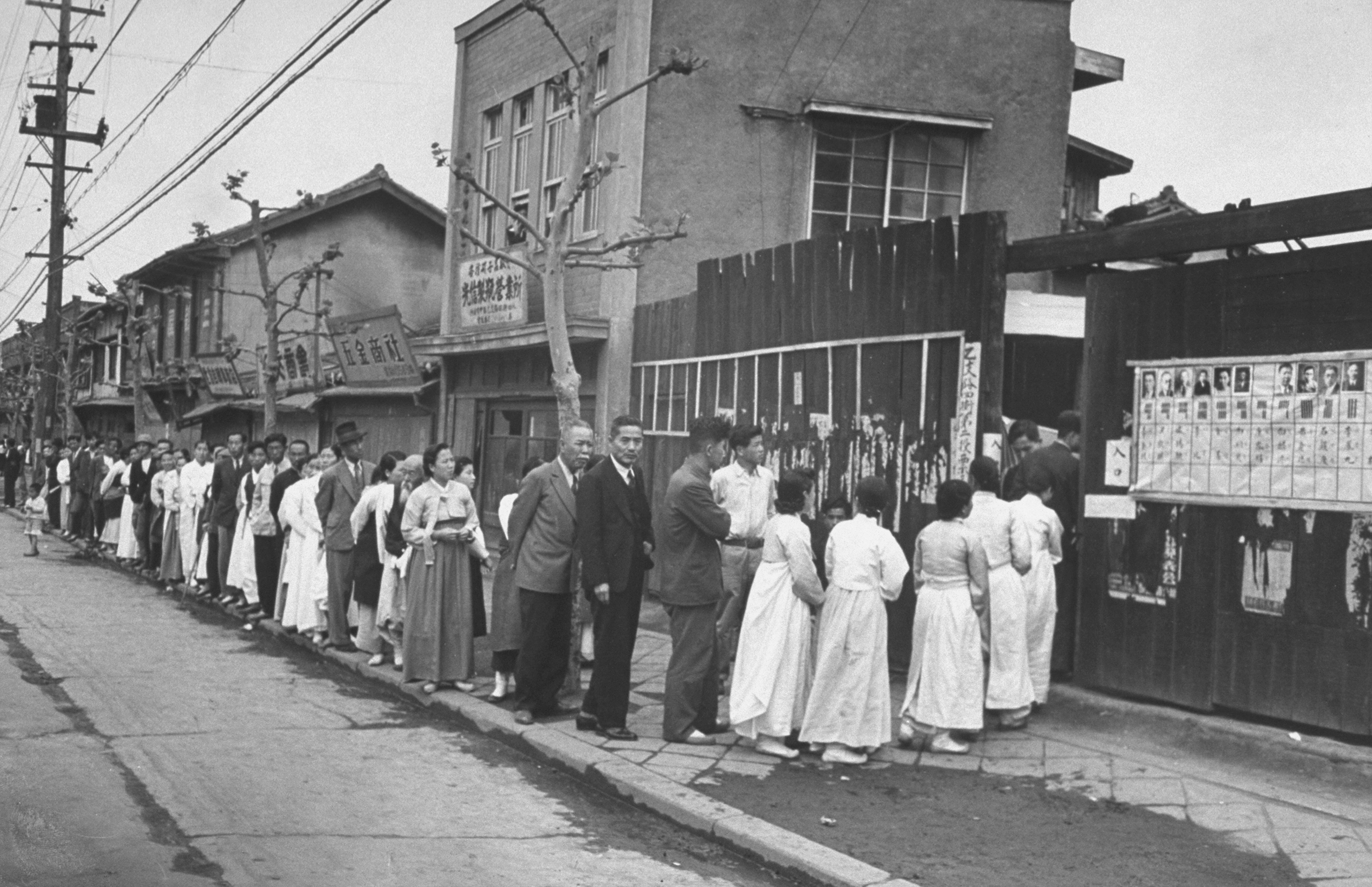
In December 1948, the Soviet Union announced that all its troops had left North Korea. The United States withdrew its last troops from South Korea in mid-1949.
Following widespread leftist uprisings against the South Korean government and border clashes between North and South, the Korean War began when North Korean troops invaded the South in June 1950. A stalemate set in by the summer of 1951. An armistice was signed in July 1953. Neither side won complete victory. The war involved the two Koreas as well as China and a number of non-Communist nations. The non-Communist nations fought under UN supervision. See Korean War. 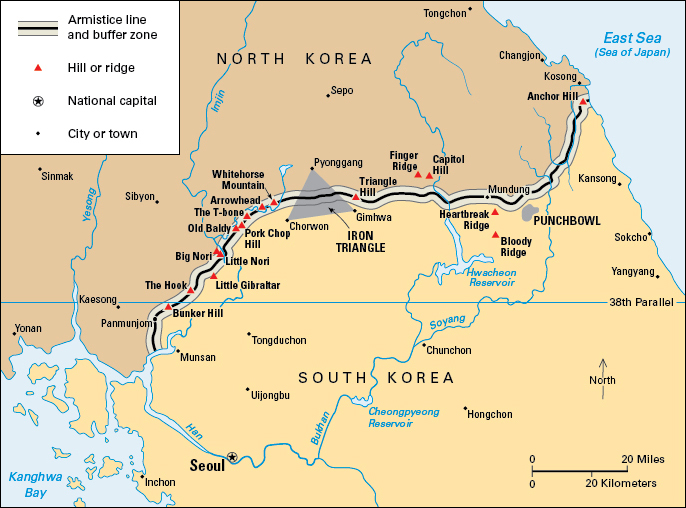
South Korea under Rhee.
The division of Korea left the South with a weak economy. It had little industry and few electric power plants. The Korean War added to South Korea’s economic problems. Fighting ruined farm crops and destroyed many factories. Hundreds of thousands of people were killed or wounded. After the war, South Korea needed to rely heavily on aid from other countries. 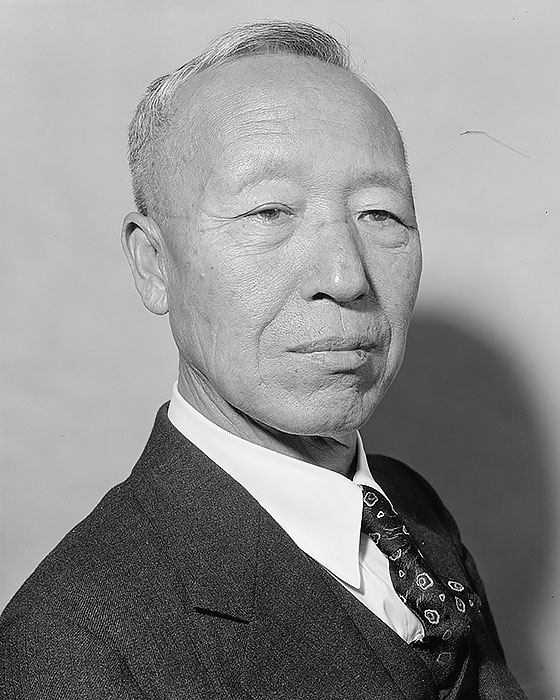
Rhee’s term was due to end in 1952. But members of the National Assembly had become increasingly critical of Rhee, and he feared the legislators would not reelect him. He pushed through the Assembly a constitutional amendment that turned over election of the president to the people. The voters reelected Rhee by a wide margin. In 1954, Rhee again had the Constitution amended, to permit him to serve more than two terms. He was reelected to a third term in 1956. But an increasing number of South Koreans strongly opposed Rhee’s undemocratic methods for keeping control of the government.
In March 1960, Rhee ran for a fourth term. He was unopposed because his main opponent died one month before the election. Rhee and his party won, but the election was rigged. In March and April, students led widespread demonstrations against the government. Government forces violently cracked down on the protesters. Rhee saw that he was rapidly losing political and military support, and he resigned in April.
A new government took office after elections in July 1960. But South Korea’s economic difficulties continued, and the new government weakened as rival groups fought for political power. In May 1961, a group of military officers led by Major General Park Chung-hee overthrew the government. Park then became head of the new government. In 1963, Park called for elections to restore democratic government. He won the election for president, and his Democratic Republican Party gained a majority of the seats in the National Assembly.
South Korea under Park.
South Korea’s economy progressed rapidly under Park. His government concentrated on developing industries and increasing foreign trade. In 1967 and 1971, Park and his party won reelection by a large margin. In 1972, Park forced through a new constitution that gave him almost unlimited powers. It provided that the president might serve an unlimited number of terms. Park was reelected by the country’s electoral college—whose members had been chosen by his supporters—in a special election held that year. He was reelected again in 1978. His party won the National Assembly elections in 1973 and 1978.
Park increasingly abused his power as president and suppressed opposition to his government. Freedom of speech and of the press were limited, and many South Koreans who opposed Park were jailed. Many of Park’s opponents denounced him as a dictator.
During the Korean War, United States troops had fought on the side of South Korea. After the war, thousands of U.S. troops were stationed in South Korea. In 1977—when about 38,000 troops remained—the United States government announced plans for a gradual withdrawal of all its troops. By mid-1979, about 10 percent of the troops had been withdrawn. But the United States government then said it would postpone further withdrawals until relations between North and South Korea improved. In 1981, U.S. President Ronald Reagan announced that no more U.S. troops would be withdrawn.
In October 1979, President Park was assassinated by Kim Jae-kyu, head of South Korea’s Central Intelligence Agency (now called the National Intelligence Service). In December, Prime Minister Choi Kyu-hah was elected president by the electoral college.
The rise of Chun.
Choi’s government ended some of the restrictions on freedom of expression that Park had imposed. But the government delayed a promised constitutional revision that would allow the people to elect the president directly. Also, military leaders soon declared martial law and reestablished the restrictions on freedom of expression. Many South Koreans then staged demonstrations. Choi remained president, but the military, led by Lieutenant General Chun Doo-hwan, dominated the government. In May 1980, violence broke out between demonstrators and the military in the city of Gwangju. Hundreds of demonstrators were killed in what came to be known as the Gwangju Uprising.
In August 1980, Choi resigned, and the electoral college elected Chun president. In October, a new constitution was adopted. Martial law was repealed in January 1981. In February, Chun was again elected by the electoral college. The next month, Chun’s Democratic Justice Party won a majority of seats in the National Assembly. Chun’s government stabilized prices and increased exports, but scandals involving Chun’s relatives lessened its popularity. Many students demonstrated against Chun and demanded a more democratic constitution.
A new constitution.
In April 1987, nationwide demonstrations erupted after Chun banned talks on constitutional reform until after the 1988 Summer Olympics in Seoul. In June 1987, Chun designated Roh Tae-woo, his close associate and a former general, as the candidate for the ruling Democratic Justice Party. Protests throughout the country called for direct election of the president by the people rather than by the electoral college. Roh announced that he would support constitutional reform and direct election of the next president. Roh won the election, which was held in December.
In October 1987, a new democratic constitution was adopted by a referendum of all the voters. It allows far greater political freedom. Since its adoption, South Korea has maintained a vibrant democracy
North-South relations.
After the Korean War ended in 1953, the two sides remained hostile and suspicious of each other. In 1967, North Korean forces began making attacks in the Demilitarized Zone (DMZ) and into South Korea. The DMZ is the neutral area between the North and the South. In 1968, North Korean commandos raided Seoul in a failed attempt to assassinate President Park.
In 1971, representatives of South and North Korea began formal reunification discussions for the first time since the Korean War. Tensions between the two remained high, however. In 1983, a bomb blast killed 17 South Koreans, including 4 cabinet ministers, during an official South Korean presidential visit to Rangoon, Burma (now Yangon , Myanmar). A court in Burma found North Korean agents guilty of the bombing. In September and October 1988, South Korea hosted the Summer Olympics. North Korea refused to participate after its request to be named co-host was denied.
In 1991, the two governments agreed to accept each other’s existence, and North and South Korea joined the UN as separate states. Also in 1991, talks resulted in several agreements, including a pact in which the two Koreas agreed not to use force against each other. As part of the pact, the two governments also agreed to increase trade and communication—which had been restricted—between them. Another accord prohibited North and South Korea from using or possessing nuclear weapons.
In 1992, Kim Young-sam, a former prodemocracy leader who had opposed Park and who represented the new Democratic Liberal Party, became the first civilian to be elected president since the 1960’s. He later renamed his party the New Korea Party.
Kim Dae-jung was elected president in 1997. He was the first politician from an opposition party—a party that does not have a majority of seats in parliament—to win South Korea’s presidency.

Much of Asia suffered severe economic problems in the late 1990’s. The value of South Korea’s currency fell, and its stock market plunged. Businesses went bankrupt, and South Korea faced widespread unemployment. By 2000, the country had largely recovered.
In 2000, Kim Dae-jung visited Pyongyang, North Korea, and met face-to-face with the North Korean leader, Kim Jong-il , to discuss inter-Korean relations. It was the first meeting between the leaders of South and North Korea since the peninsula was divided. As a result of this meeting, the two countries took more steps toward improving relations. For example, some North Korean and South Korean relatives were allowed to visit one another, and road and rail links were reestablished between the two countries. In 2004, some South Korean companies began employing North Korean workers in a special industrial zone in Kaesong , North Korea.
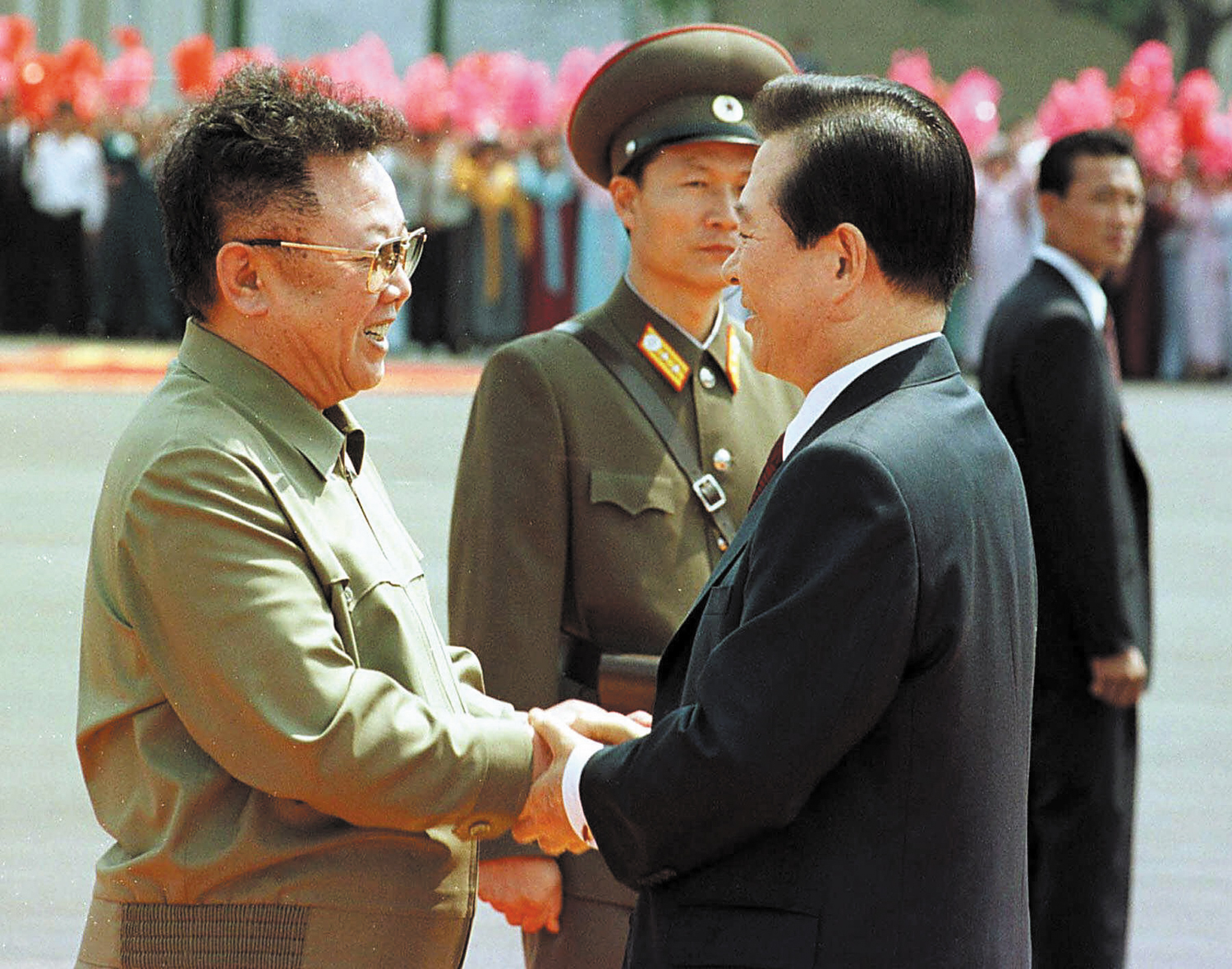
Recent developments.
In presidential elections in 2002, voters elected Roh Moo-hyun , the candidate from Kim Dae-jung’s Millennium Democratic Party (MDP). Roh took office in 2003. In September of that year, he left the MDP. In March 2004, South Korea’s National Assembly voted to impeach Roh, accusing him of election law violations and incompetence. In elections in April, the Uri Party, which supported Roh, won a majority in the National Assembly. In May, South Korea’s Constitutional Court overturned Roh’s impeachment, and he was reinstated as president.
In 2007, voters elected former Seoul Mayor Lee Myung-bak to the presidency. He served from 2008 to 2013. Corruption allegations against Roh continued, and Roh took his own life in 2009.
In 2012, South Korea began to move some of its government offices from Seoul to the Sejong Metropolitan Autonomous City. The government had began building the city several years earlier to serve as an administrative center. Sejong City is located about 75 miles (120 kilometers) south of Seoul.
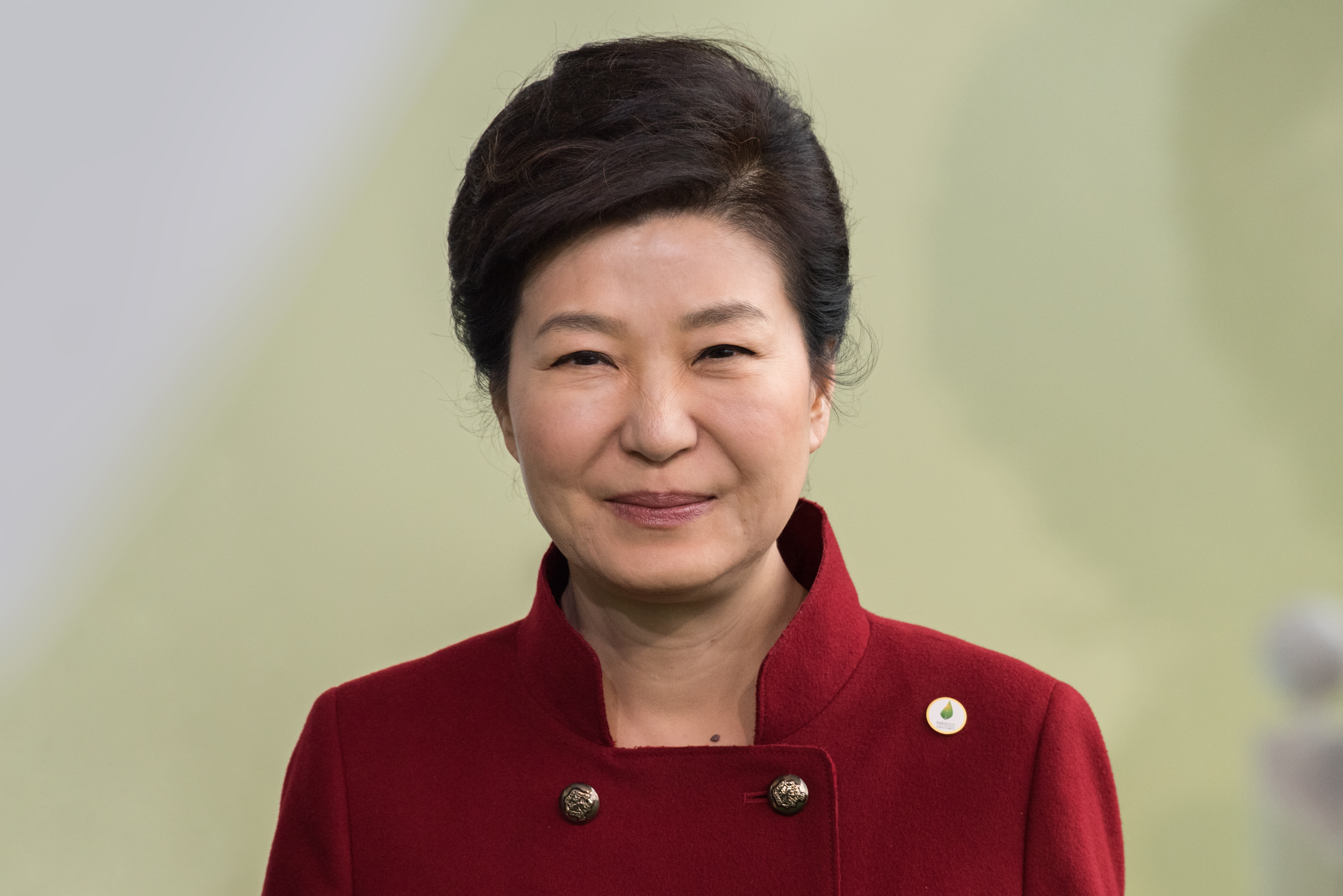
In 2012, voters elected Park Geun-hye, daughter of former President Park Chung-hee, to become the country’s first woman president. She took office in 2013. In 2016, South Korea’s National Assembly voted to impeach her over allegations of corruption and abuse of power. In 2017, the Constitutional Court upheld the impeachment vote, and Park was removed from office. Voters then elected former human rights lawyer Moon Jae-in president.
In 2018, Park was sentenced to prison for abuse of power, corruption, and other charges. Lee Myung-bak was convicted on unrelated corruption charges later that year. Both former presidents were fined large sums, and both lost appeals of their convictions. However, Park was pardoned in 2021, and Lee was pardoned in 2022.
The 2018 Winter Olympic Games were held in Pyeongchang, South Korea. North and South Korean athletes marched into the stadium together during the opening ceremony under a flag depicting a unified Korean peninsula. Athletes from North and South Korea also played on a single women’s hockey team.
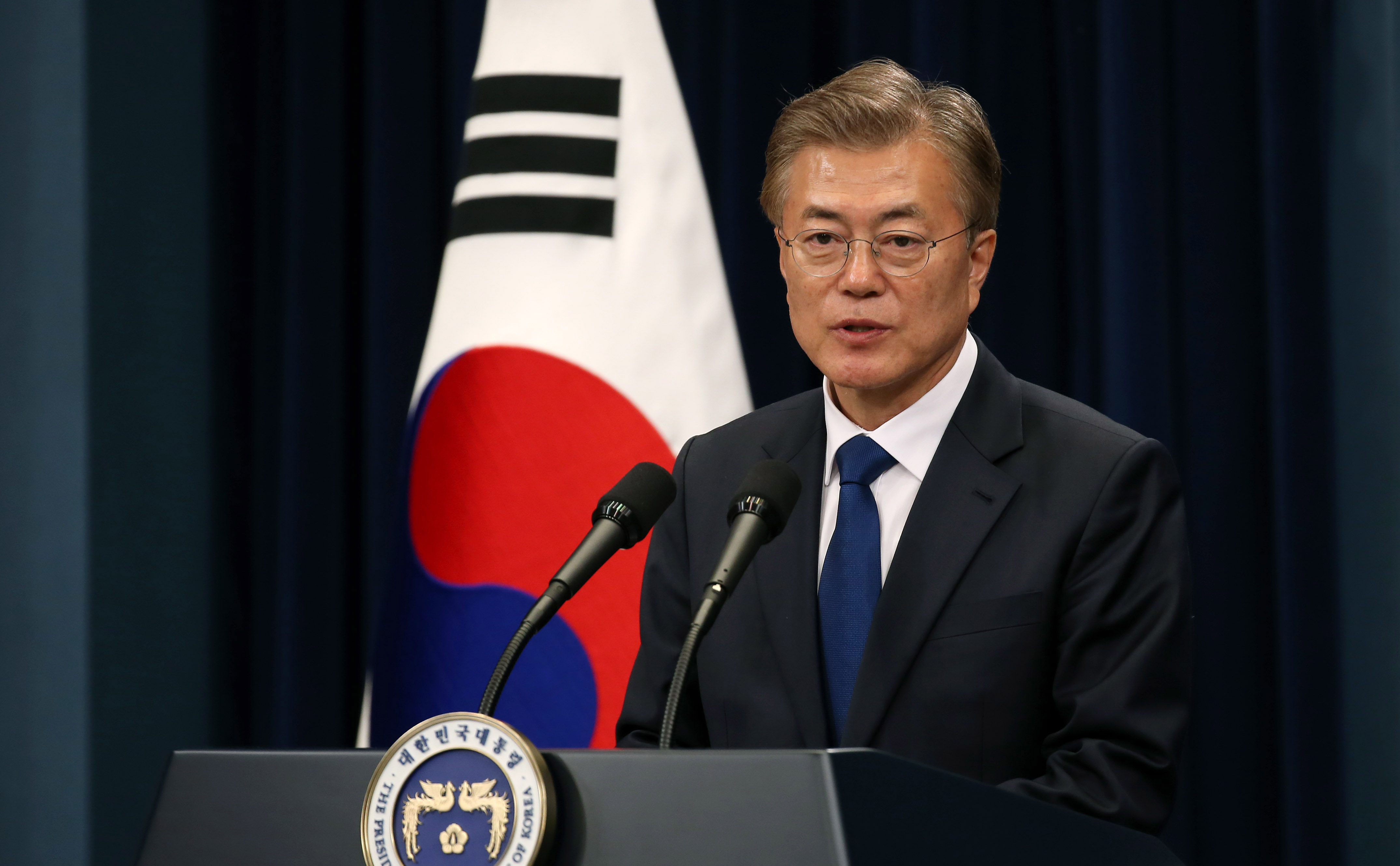
In April 2018, South Korean President Moon Jae-in and North Korean leader Kim Jong-un held a meeting at Panmunjom, in the Demilitarized Zone, for the first of several summits between them that year. At the meeting, the two leaders pledged to remove nuclear weapons from the Korean Peninsula and to work toward reaching a formal peace agreement to officially end the Korean War. However, tensions mounted again in 2019.
Beginning in early 2020, South Korea faced the challenges of the COVID-19 pandemic (global epidemic). COVID-19, a sometimes-fatal respiratory disease caused by a type of coronavirus, originated in China in late 2019. South Korea’s first case of COVID-19 was reported in late January 2020. The country’s experience in dealing with other coronavirus outbreaks, including a deadly Middle East respiratory syndrome (MERS) outbreak in 2015, helped shape its response to COVID-19. The government quickly began testing people for the virus and tracking cases of infection. People widely adopted such protective measures as wearing masks and social distancing. These actions contributed to a dramatic decrease in the number of new infections.
South Korea’s COVID-19 vaccination program began in February 2021. As new and more contagious variants of the virus emerged, the challenge of containing it continued into 2022 and the nation experienced a spike in cases. However, the number of cases had declined by late spring, and the government eased many of its restrictions. By early 2023, more than 30 million people in South Korea had been infected with the virus, and more than 30,000 had died from the disease.
In March 2022, the people elected Yoon Suk-yeol, the nation’s former prosecutor general, as president. Yoon, the leader of the conservative People Power Party, took office as president in May.
